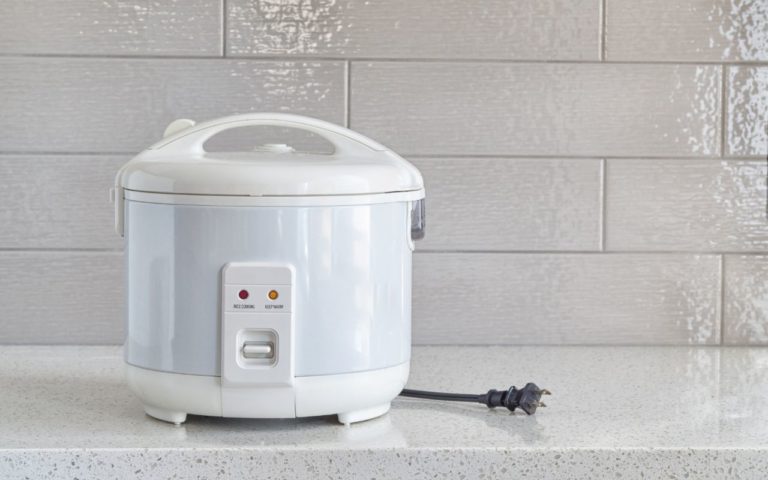ⓘ We are reader-supported and may earn a small commission at no additional cost to you if a purchase is made through one of our links.
With the help of a rice cooker, you can easily cook different grains of rice without worries. Best of all, you will get consistent results every time. These appliances have completely changed how people prepare rice, thanks to their convenient design.
They not only automate the cooking process but will also provide you with well-cooked fluffy rice. Additionally, rice cookers are very easy to use, making them ideal for anyone who is looking to upgrade their rice cooking skills.
However, having the best rice cooker is never enough. You need to learn how you can use your rice cooker to get the best results.
What is a Rice Cooker?
A rice cooker, also known as a rice steamer, is an electrical appliance designed for steaming rice. Rice cookers feature large cooking bowls in which rice is placed. They are also fitted with a thermostat for precision cooking.
That said, a rice cooker can regulate the cooking temperature automatically, so you won’t have to worry about anything provided that you do everything correctly. As with most cooking appliances, there are different types of rice cookers that you can choose from.
Depending on your needs, you can buy a jar-o-mat rice cooker, standard electric rice cooker, induction rice cooker, or microcomputer rice cooker. If you don’t prefer the electric models, you can go for a gas rice cooker. All these types of rice cookers will deliver great results when used the right way.
How to Cook Rice in a Rice Cooker
If it’s your first time using a rice cooker, the steps below can guide you through the cooking process:
Step 1: Measure your rice
To avoid complications when cooking your rice, ensure that you measure the correct portion. You should consider the capacity of your rice cooker, as this will determine whether the rice will fit in the unit once it has been cooked.
If you’ve ever cooked rice, then you must be aware that the grains can triple or double in weight and volume when cooked. As such, a cup of white uncooked rice may give you up to three cups of cooked rice. This may, however, vary from one type of grain to another. It is advisable that you only cook the amount of rice that you need to avoid food wastage.
Step 2: Thoroughly wash the rice
This step is optional for some people, but there are those who prefer their rice rinsed. Washing rice before cooking can help remove residual starch dust from the grains. This will prevent the rice grains from sticking together when cooking, thus providing you with fluffier rice.
But most importantly, rinsing rice reduces your chances of consuming harmful substances that may have come into contact with the grains during transit. For best results, the rice water should change colour from milky white to clear. You can use a strainer to prevent the rice from pouring into the sink.
Step 3: Transfer the rice to the inner pan
Once you are done cleaning the rice, you can transfer it into the inner cooking bowl. If you like, you can line the bowl with a rice napkin to allow for easy cleaning later.
Step 4: Add water
The amount of water used when cooking rice will determine the type of results that you will get. When adding water, you should use the same glass that was used when measuring the rice. The amount of rice and water in the cooking pan should be in the ratio of 1:1.
This will provide you with fluffy rice when cooking most grains. Nonetheless, some grain types may require you to add more water, so ensure that you go through the preparation instructions to get the desired outcome.
Step 5: Add your ingredients (optional)
You can make your rice more flavourful by adding salt, unsalted butter, parsley, and any other ingredient that you would like to use. This step is optional because rice can be cooked using just water. Stir the rice to mix up the ingredients.
Step 6: Insert the inner bowl into the cooker
Now that you are done with the preparation process, you can place the cooking bowl in the cooker and then close the lid. The lid will ensure the rice comes out moist and fluffy.
You need to keep in mind that the lid should stay closed throughout the cooking process to prevent heat loss. Transparent lids are highly preferred since they allow you to check the cooking progress without interfering with the rice cooker.
Step 7: Switch on the rice cooker
Plug in your rice cooker and engage the start button/switch. If you are using a programmable model, you can customise the settings to match the type of rice grain that you are cooking.
You will be happy to know that rice cookers can automatically regulate the temperature in different stages of the cooking process. This will prevent the rice from sticking to the bottom of the inner cooking bowl.
The rice should take about 25 to 30 minutes to cook properly. The time can vary depending on the amount of water used and the grain type. Also, a good number of these units feature an auto shutoff function for user convenience.
Step 8: Use the keep warm function
You shouldn’t open the lid immediately when the rice has finished cooking. Instead, switch the rice cooker to keep warm mode. That way, the grains will absorb just the right amount of moisture to give you the right level of fluff.
Conclusion
It does not matter the type of rice grain that you are cooking, most rice cookers will get the job done in less than 40 minutes. Ensure that you add the right amount of water and keep the lid closed to prevent the rice from drying out.
After you learn how to use a rice cooker, you will never go back to the old ways of cooking rice. Moreover, these pieces of equipment are designed with your cooking needs in mind, so rest assured you won’t experience any problems.



